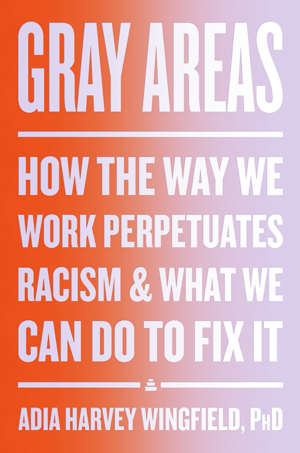 c.2023, Amistad
c.2023, Amistad
$29.99
304 pages
By Terri Schlichenmeyer
The Truth Contributor
Well. This wasn’t what you wanted.
It was supposed to be better than this, wasn’t it? But it’s not anywhere close to what it should be. No, you expected different and that’s not right. Read the new book Gray Areas by Adia Harvey Wingfield, PhD, and you might have to think about this again.
There you are, logged into your work computer after a long weekend and it hits you: an email or IM from a racist who uses vile words and hides behind a pseudonym. It happens, and for many Black employees in America today, it happens so often that it’s become “a core part of the Black experience…”
But hey, your jobsite established diversity programs and workshops on inclusion, right? Yes, but the truth, says Wingfield, is that they don’t help; in fact, she believes that those well-intended workplace efforts actually “perpetuate and maintain racial divides.”
Part of the problem is that today’s workplace thrives on “cultural, social, and relational aspects.” These are things built into most workplaces, but that ignore Black experiences.
There are four classes of culture at work and, for various reasons, any or all of them can “make it hard for Black workers to fit in…” by subtly forcing them to hide their true selves. Social aspects in the workplace deal with connections, mentors, and relationships. It’s not what you know, but who, and networking – something with which Black workers sometimes struggle – is key. And relational aspects relate to “soft skills” and leadership abilities, although most top-echelon positions in corporate America are filled by white men.
So what can a supervisor or CEO do to make the workplace less racist?
End mandatory diversity training, Wingfield says, and hire diversity managers instead. Admit and anticipate racial issues. Don’t let employees or customers to get away with bigotry against your workers. Start a mentoring program in your workplace and strive to promote workers of color to top positions.
With these, and other ideas, Wingfield says, “We can do better.”
Reading Gray Areas is a little bit of a struggle.
For an African American reader, author Adia Harvey Wingfield, PhD, shares the lives and words of several people at various kinds of workplaces, but the case studies mostly repeat what you probably already know. It’ll get your dander up, but it won’t tell you much.
On the other hand, CEOs and supervisors need to absorb what’s inside this book, to glean understanding from the various viewpoints and experiences and to uncover that which they may not see. Just know that, aside from end-of-chapter bullet-points, advice is pretty well buried – although golden nuggets do exist. For instance, if you’re a people-watcher, it’s interesting to see how different folks deal with difficulties at work. On that, readers may come away wishing that Wingfield’s subjects could’ve networked among themselves.
Should you decide to tackle this book and its information, taking extra time to think and absorb will help immensely. Do that, let yourself cogitate, and Gray Areas could be everything you’ve wanted.

